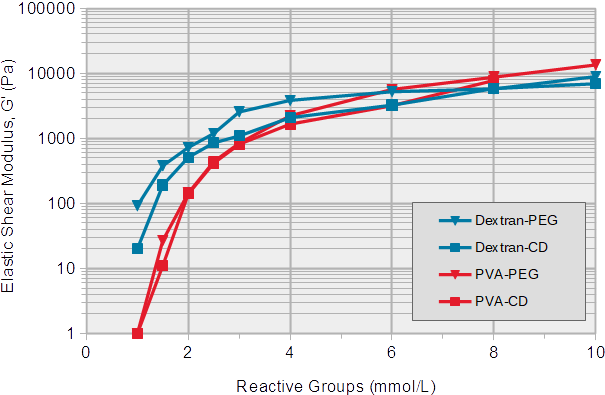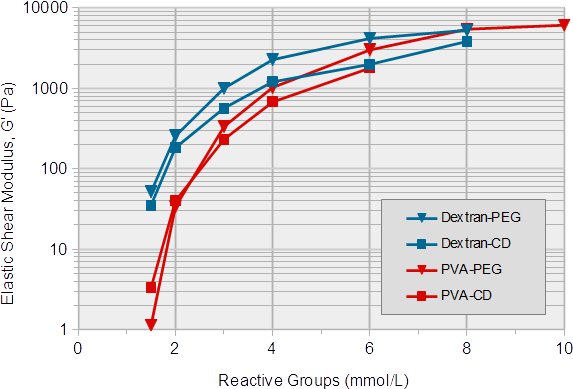Hydrogel Stiffness

Stiffness and Tissue Function
The mechanical properties of the extracellular matrix are important for the regulation of cell behavior (1) and other tissue functions. Therefore, matrix stiffness is an important experimental parameter for in vitro 3D cell cultures.
3-D Life Hydrogels can be formed with stiffnesses of up to a 10 kPa dynamic shear modulus. Therefore, the stiffness of a broad range of mammalian tissues (2) can be modeled.
Both, the thio-reactive polymers and the thiol-containing crosslinkers of the 3-D Life System, which are the basic reagents for forming hydrogels, are supplied as highly concentrated stock solutions. The stiffness of the hydrogels can easily be varied by adjusting the final concentration of these two reagents.
Stiffness of 3-D Life Slow-Gelling Hydrogels
Slow gelling hydrogels (SG series) are used for a broad range of applications, with a soft to medium high stiffness, because the gelation time is long enough to easily handle the solutions. Figure 1 shows gel stiffnesses and corresponding concentrations of reactive groups of the polymers.
Gel formation starts at a concentration of 1 mmol/L reactive groups with a very low stiffness of 20-100 Pascal (Pa). With increasing concentrations of reactive groups, the stiffness of the hydrogels increases up to 10 kPa at a concentration of 10 mmol/L reactive groups. Below 4 mmol/L, the PVA-based hydrogels were softer than the dextran-based gels. The shear loss modulus (G''), a measure for the viscosity of the hydrogel, remained very low (below 2% of the G') in all combinations (data not shown).

Stiffness of 3-D Life Fast-Gelling Hydrogels
3-D Life Fast Gelling Hydrogels (FG series) are mainly used for the generation of soft hydrogels, since at higher stiffnesses, the gelation time becomes too short for a practical handling. Exceptions are automated pipetting and bioprinting applications. Figure 2 shows the stiffnesses of hydrogels formed at increasing concentrations of fast reacting polymers (FG series) and crosslinkers.
At a concentration of 1.5 mmol/L of each reactive group, all polymer combinations develop a very low hydrogel stiffness (an elastic shear modulus (G') below 100 Pa). This is markedly softer than the stiffnesses obtained from slow gelling gels at the same concentrations (compare Fig. 1). Below 6 mmol/L, the fast-gelling PVA-based hydrogels were softer than the fast-gelling dextran-based gels. At higher concentrations the stiffness increases up to 4-5 kPa. The shear loss modulus (G''), a measure for the viscosity of the hydrogel, remained very low (below 2% of the G') in all combinations (data not shown).
Literature
- Wells RG. The role of matrix stiffness in regulating cell behavior. Hepatology. 2008 Apr;47(4):1394-1400.Wells RG. The role of matrix stiffness in regulating cell behavior. Hepatology. 2008 Apr;47(4):1394-1400.
- Chen WLK, Simmons CA. Lessons from (patho)physiological tissue stiffness and their implications for drug screening, drug delivery and regenerative medicine. Adv Drug Deliv Rev. 2011 Apr 30;63(4-5):269-276.
